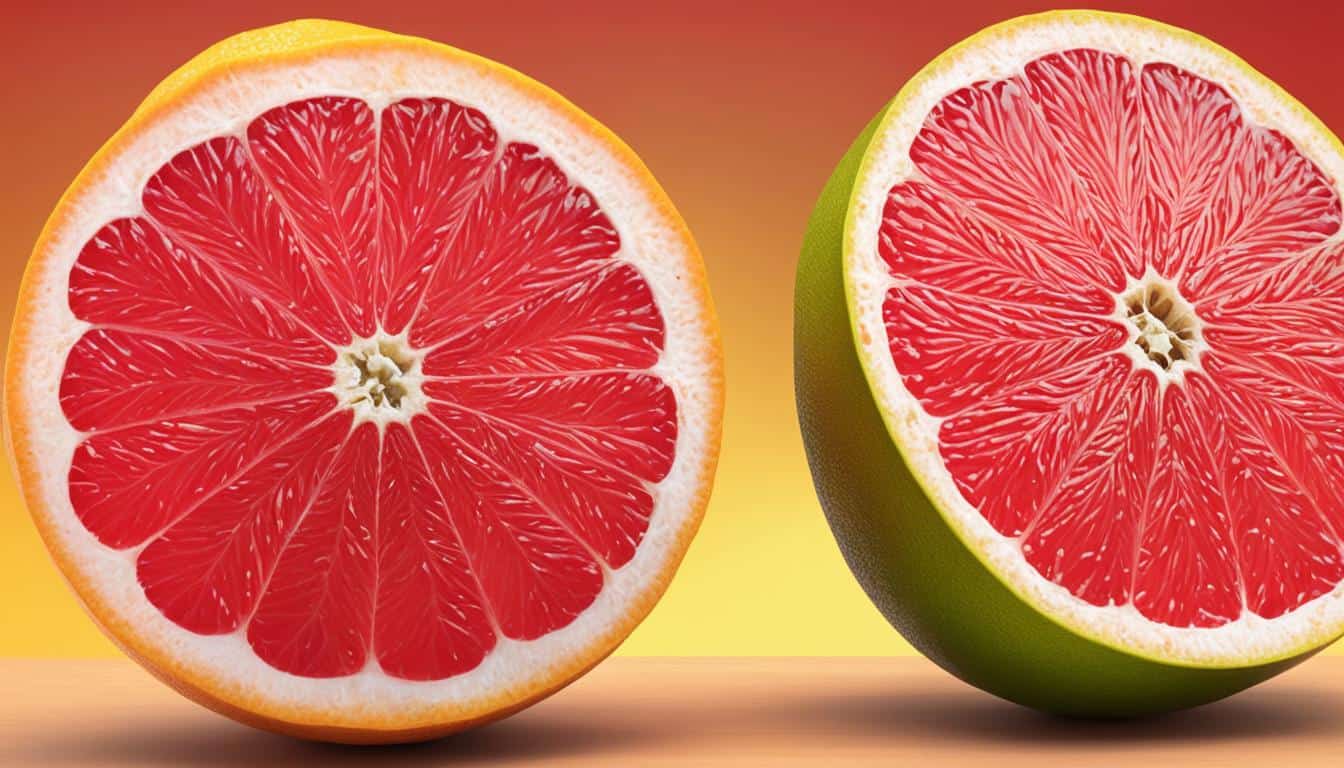I’m excited to introduce you to a world of citrus delights! If you’re a fan of grapefruits but want to explore other fruit varieties with similar flavors and characteristics, you’re in for a treat. Join me as we dive into the wonderful world of citrus fruits, including pomelos, tangelos, oroblanco, and more!
When it comes to citrus fruits, the grapefruit stands out with its tangy yet refreshing flavor. But did you know that there are other fruits that share similar taste profiles? Let’s take a closer look at some of these tasty alternatives.
Key Takeaways:
- Discover a variety of citrus fruits similar to grapefruit, including pomelos, tangelos, and oroblanco.
- Explore the differences in appearance, taste, and texture between pomelos and grapefruits.
- Learn about the origins and growth patterns of both fruits.
- Uncover the health benefits of pomelos and grapefruits, such as their vitamin C and antioxidant content.
- Get inspired with ideas on how to use pomelos and grapefruits in your kitchen.
Pomelo vs. Grapefruit: Origins and Growth
When it comes to the origins and growth patterns of pomelos and grapefruits, there are distinct differences between these citrus fruits.
Pomelos, also known as Citrus maxima, are a separate species native to Southeast Asia, particularly Malaysia, Thailand, and Indonesia. These fruits grow on trees as solitary fruits and have a pear or teardrop shape. They are known for their large size, thick rind, and sweet taste. Pomelos thrive in warm climates and are primarily cultivated in Southeast Asia.
Grapefruits, on the other hand, are a hybrid fruit resulting from the crossbreeding of a sweet orange and a pomelo. They originated in Barbados in the Caribbean and got their name due to their growth pattern in clusters, resembling grapes on a vine. Grapefruits are characterized by their round shape and come in various colors like yellow, orange, and pink. They can be found in different regions worldwide and are cultivated in warm climates.
The distinct origins and growth patterns of pomelos and grapefruits contribute to the differences in their size, taste, and appearance.
Continue reading to explore more differences between these two citrus fruits, including their appearance, taste, and availability.
Pomelo vs. Grapefruit: Appearance and Size
When it comes to appearance, pomelos and grapefruits have distinct differences. Pomelos have a thicker rind than grapefruits, which gives them a more substantial look. The rind of a pomelo is usually yellow or light green, while grapefruits can range from pale yellow to vibrant orange, pink, or even reddish hues.
In terms of size, pomelos are the largest citrus fruits, reaching sizes comparable to small melons. They are typically 7 to 10 inches in diameter. Grapefruits are smaller, averaging about 4 to 6 inches in diameter. Pomelos also have an oval shape, resembling avocados, while grapefruits are more rounded like softballs.
The Visual Comparison of Pomelo and Grapefruit
| Pomelo | Grapefruit | |
|---|---|---|
| Appearance | Thicker rind, yellow or light green | Ranging from pale yellow to vibrant orange, pink, or reddish hues |
| Size | Largest citrus fruit, 7 to 10 inches in diameter | Smaller, 4 to 6 inches in diameter |
| Shape | Oval, resembling avocados | Rounded, like softballs |
Pomelo vs. Grapefruit: Taste and Texture

“Grapefruits have a denser and chewier texture, often packed with refreshing juiciness.”
From the juicy and succulent texture of pomelos to the dense and refreshing juiciness of grapefruits, these citrus fruits offer a tactile experience that enhances their overall appeal.
| Pomelo | Grapefruit |
|---|---|
| Sweet and mild taste | Tangy and slightly bitter taste |
| Pale yellow or pink flesh | Bright pink or red flesh |
| Juicy and succulent texture | Denser and chewier texture |
Pomelo vs. Grapefruit: Availability and Seasonality

When it comes to the availability and seasonality of pomelos and grapefruits, there are some key differences to consider. Pomelos, which are native to Southeast Asia, can be found in local markets and grocery stores in that region. They thrive in warm climates and are typically in season during late summer and early winter. However, outside of Southeast Asia, finding fresh pomelos may be more challenging due to limited availability.
In contrast, grapefruits are more widely cultivated and distributed globally, making them more readily available in various regions. You can find grapefruits in grocery stores throughout the year, although their peak season may vary depending on the specific variety and location. For example, in regions like Florida in the United States, grapefruits are more abundant and readily available due to favorable growing conditions and a booming citrus industry.
It’s worth noting that the availability of both pomelos and grapefruits can also be influenced by factors such as weather conditions, transportation logistics, and market demand. However, overall, grapefruits tend to have a more consistent presence in the fruit market compared to pomelos.
The table below summarizes the availability and seasonality of pomelos and grapefruits:
| Citrus Fruit | Availability | Seasonality |
|---|---|---|
| Pomelo | Less readily available, especially outside of Southeast Asia | Late summer and early winter |
| Grapefruit | Widely cultivated and distributed globally | Varies depending on variety and location |
Health Benefits of Pomelo

Pomelos offer a range of health benefits due to their nutritional composition. They are a rich source of vitamin C, which acts as a powerful antioxidant, supports immune system function, and aids in collagen production. Pomelos also contain cancer-fighting antioxidants, such as flavonoids and limonoids, which contribute to overall health and may have potential anti-inflammatory effects.
Furthermore, the fiber content in pomelos promotes healthy digestion, prevents constipation, and supports a healthy gut microbiome. Fiber is essential for maintaining regular bowel movements and preventing digestive issues. Moreover, pomelos are a good source of essential nutrients like copper and potassium.
| Nutrient | Amount per 100g |
|---|---|
| Calories | 38 |
| Carbohydrates | 9.6g |
| Fiber | 1.0g |
| Vitamin C | 61.0mg |
| Potassium | 216mg |
| Copper | 0.1mg |
By incorporating pomelos into your diet, you can enjoy their delicious taste while reaping the numerous health benefits they offer. Whether you enjoy them on their own, in salads, or as part of your favorite recipes, pomelos are a nutritious addition to any meal.
Health Benefits of Grapefruit
When it comes to health benefits, grapefruits are just as impressive as their citrus cousin, the pomelo. Packed with essential nutrients and antioxidants, grapefruits offer a wide range of advantages for overall well-being.
One of the standout benefits of grapefruits is their high vitamin C content. Vitamin C is a powerful antioxidant that helps protect the body’s cells from damage caused by free radicals. It also plays a crucial role in boosting the immune system, supporting collagen production, and promoting healthy skin.
In addition to vitamin C, grapefruits contain other antioxidants that contribute to their health benefits. These antioxidants help combat oxidative stress and inflammation in the body, reducing the risk of chronic diseases and promoting optimal health.
Grapefruits are also an excellent source of fiber, which is essential for maintaining a healthy digestive system. Fiber aids in digestion, prevents constipation, and supports a healthy gut microbiome. It can also help promote satiety, making grapefruits a satisfying snack for weight management.
Furthermore, grapefruits have been recognized for their positive impact on heart health. The fiber content in grapefruits helps reduce inflammation and maintain healthy cholesterol levels, which are crucial for a healthy cardiovascular system. Incorporating grapefruits into a balanced diet can contribute to improved heart health and reduced risk of heart disease.
Another notable benefit of grapefruits is their hydrating properties. With a high water content, grapefruits can aid in maintaining hydration levels, particularly in warm weather or during physical activity.
Overall, grapefruits offer a flavorful way to support good health. Their vitamin C content, antioxidants, fiber, and heart-healthy properties make them a valuable addition to a balanced diet.
| Nutrient | Amount per Serving |
|---|---|
| Calories | 52 |
| Carbohydrates | 13 grams |
| Fiber | 2 grams |
| Protein | 1 gram |
| Vitamin C | 60% of the Daily Value |
| Potassium | 5% of the Daily Value |
As you can see, grapefruits are a low-calorie fruit packed with essential nutrients. Incorporating them into your diet can help support your health and well-being.
Using Pomelo and Grapefruit in the Kitchen

Both pomelos and grapefruits offer a delightful range of culinary possibilities. With their tangy and sweet flavors, these citrus fruits are perfect for enhancing fruit salads, providing a refreshing twist. Whether you’re looking for a zesty kick or a subtle hint of sweetness, pomelos and grapefruits can be juiced to create delicious citrus beverages such as freshly squeezed pomelo or grapefruit juice.
These versatile fruits can also be used to elevate desserts, adding vibrant flavors to citrus tarts or sorbets. You can even enjoy them as a standalone treat, glistening with the natural juiciness of the fruits. In savory dishes, pomelo and grapefruit segments create a tangy burst of flavor in seafood salads, while their vibrant appearance makes them an eye-catching garnish.
Let your creativity shine in the kitchen with these versatile fruits, and experiment with different pomelo recipes and grapefruit recipes that showcase their unique flavors and textures. Whether it’s a colorful citrus fruit salad, a refreshing citrus fruit juice, or a delectable citrus fruit dessert, pomelos and grapefruits are sure to liven up your culinary creations.
Pomelo and Grapefruit Recipes
| Recipe | Description |
|---|---|
| Pomelo Salad | A vibrant salad combining pomelo segments, mixed greens, avocado, and a tangy citrus dressing. |
| Grapefruit Granita | A refreshing frozen dessert made with freshly squeezed grapefruit juice, sugar, and a hint of mint. |
| Pomelo Salsa | A zesty salsa with pomelo, jalapeno, red onion, cilantro, lime juice, and a touch of honey. |
| Grapefruit Tart | A delightful pastry crust filled with a creamy grapefruit custard and topped with candied grapefruit slices. |
| Pomelo Mojito | A refreshing twist on the classic mojito, with muddled pomelo, mint leaves, lime juice, and rum. |
| Grapefruit Sorbet | A light and tangy sorbet made with freshly squeezed grapefruit juice, sugar, and a touch of lemon zest. |
Get creative with these pomelo and grapefruit recipes, exploring the vibrant flavors and versatility of these citrus fruits in your kitchen. Whether you’re looking for a light and refreshing citrus fruit salad, a zingy citrus fruit juice, or a delightful citrus fruit dessert, pomelos and grapefruits are sure to elevate your culinary experience.
Other Fruits Similar to Grapefruit
In addition to pomelos and grapefruits, there are other fruit varieties that share similar characteristics and flavors with grapefruit. Let’s explore some of these citrus hybrids:
Tangelos
Tangelos are a crossbreed fruit resulting from the combination of a tangerine with a grapefruit or pomelo. They have a delightful combination of sweetness and tanginess, with a distinct floral aroma. Tangelos are known for their juicy and refreshing taste, making them a popular choice for those who enjoy the flavors of grapefruit but prefer a sweeter profile. They can be enjoyed fresh or used in various culinary applications, adding a burst of citrus flavor to salads, desserts, and beverages.
Oroblanco
Oroblanco is another intriguing citrus hybrid, created by crossbreeding pomelo with white grapefruit. This unique combination results in a fruit with a sweet and mild flavor, balancing the sweetness of the pomelo with the gentle notes of the white grapefruit. Oroblanco is loved for its juicy and refreshing qualities, offering a pleasant eating experience. It can be used in cooking and baking to add a subtle citrus twist to dishes or enjoyed on its own for a refreshing snack.
Citrus Hybrids
Throughout the years, citrus enthusiasts and horticulturalists have developed a wide range of citrus hybrids that cater to different taste preferences. These crossbreed fruits combine the best qualities of various citrus varieties, resulting in unique flavor profiles, textures, and appearances. These hybrids are constantly evolving, offering exciting new fruit varieties for exploration and enjoyment.
Exploring fruit varieties similar to grapefruit, such as tangelos, oroblanco, and other citrus hybrids, can provide a diverse range of taste experiences and expand your citrus fruit palate. These fruits offer a wonderful blend of flavors, combining the beloved qualities of grapefruit with unique characteristics that make them stand out. Whether you’re seeking a sweeter taste or a different texture, these fruit varieties are sure to delight your taste buds.
Conclusion
In conclusion, when comparing pomelos and grapefruits, it’s clear that these citrus fruits have their own unique characteristics that set them apart. Pomelos are known for their larger size, sweeter taste, and thicker rind, while grapefruits offer a tangier and slightly bitter flavor with a thinner rind.
Both pomelos and grapefruits are packed with health benefits, including being a good source of vitamin C, antioxidants, and fiber. However, availability may vary depending on the region. Pomelos are native to Southeast Asia and are more commonly found in local markets in that area, while grapefruits are widely cultivated and accessible globally.
When it comes to culinary applications, both pomelos and grapefruits can be utilized in various recipes to add a refreshing citrus flavor. They can be enjoyed in fruit salads, used to make fresh juices, or incorporated into desserts. Additionally, exploring other fruit varieties similar to grapefruit, such as tangelos and oroblanco, can provide a diverse range of taste experiences for those seeking alternatives.
FAQ
What are some fruits similar to grapefruit?
Some fruits similar to grapefruit include pomelo, tangelo, and oroblanco.
What is the difference between pomelo and grapefruit?
Pomelos have a thicker rind and are generally larger, while grapefruits are rounder and come in various colors. Additionally, pomelos have a sweeter taste compared to the tangy and slightly bitter flavor of grapefruits.
Where do pomelos and grapefruits originate from?
Pomelos are native to Southeast Asia, particularly Malaysia, Thailand, and Indonesia. Grapefruits originated in Barbados in the Caribbean.
How do pomelos and grapefruits differ in appearance and size?
Pomelos have a thicker rind and are larger, ranging from 7 to 10 inches in diameter and having an oval shape. Grapefruits, on the other hand, have a thinner rind and are smaller, averaging about 4 to 6 inches in diameter and having a rounded shape.
What do pomelos and grapefruits taste like?
Pomelos have a sweet and mild flavor, while grapefruits have a tangy and slightly bitter taste. The flesh of pomelos is typically pale yellow or pink and has a juicy and succulent texture, while grapefruits have bright pink or red flesh and a more vibrant tang underlying the flavor.
When are pomelos and grapefruits available?
Pomelos are typically in season during late summer and early winter, while grapefruits are more widely cultivated and can be found in grocery stores throughout the year, although their peak season varies.
What are the health benefits of pomelo?
Pomelos are a rich source of vitamin C, antioxidants, and fiber. They support immune system function, aid in collagen production, have potential anti-inflammatory effects, promote healthy digestion, and provide essential nutrients like copper and potassium.
What are the health benefits of grapefruit?
Grapefruits offer similar health benefits to pomelos, including vitamin C, antioxidants, and fiber. They help protect cells from damage, boost immune system function, promote heart health, reduce inflammation, maintain healthy cholesterol levels, support weight management, and reduce the risk of chronic diseases.
How can pomelo and grapefruit be used in the kitchen?
Pomelo and grapefruit can be used in fruit salads, juiced for citrus beverages, incorporated into desserts like tarts or sorbets, and used in savory dishes like seafood salads or as a bright garnish.
Are there other fruits similar to grapefruit?
Yes, there are other fruits similar to grapefruit, including tangelos and oroblanco, which are citrus hybrids resulting in unique flavor profiles.





Leave a Reply